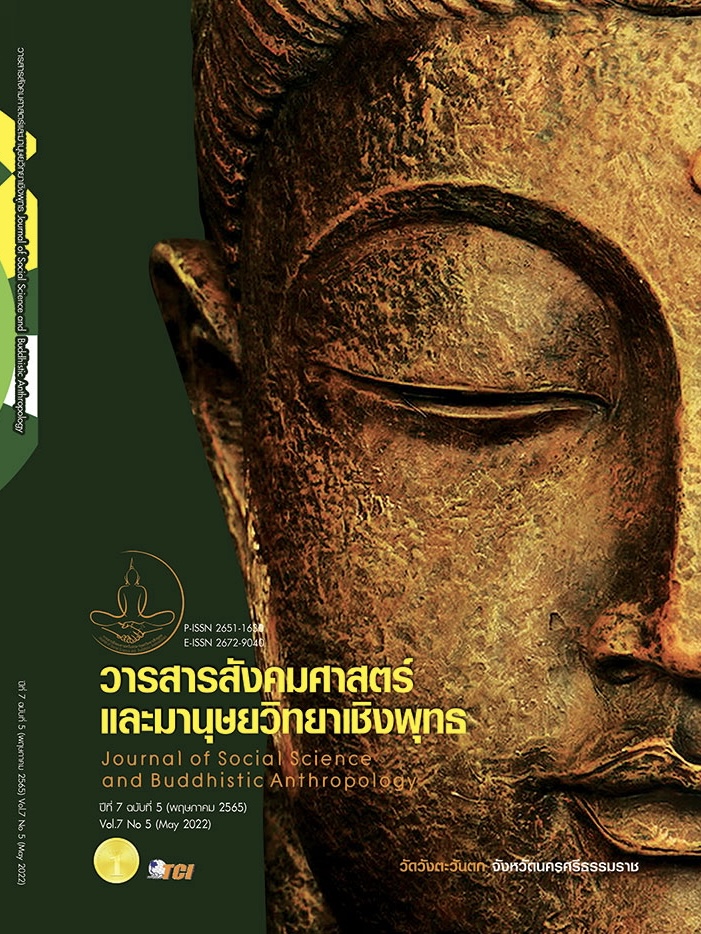AN ANALYTICAL STUDY OF METAPHYSICAL INTERPRETATIONS OF THE BIRTH (JATI) ACCORDING TO THERAVADA BUDDHIST PHILOSOPHY
Keywords:
Analysis, Interpretations, The birth (Jati), Metaphysics, Theravada Buddhist philosophyAbstract
The objectives of this research article were to 1) study interpretative methods according to Theravada Buddhist philosophy, 2) study metaphysical concepts of birth (Jati) according to Theravada Buddhist philosophy, and 3) analyze metaphysical interpretations of birth (Jati) according to Theravada Buddhist Philosophy. It was a qualitative research which focused on documentary research by studying data from the Tripitaka, the Atthakatha, the Dika, the Anutika, Pakornvises, books, textbooks, articles, documents and related research works. The data were analyzed and the research results were presented in the form of a descriptive analysis according to the research objectives. The results of research found that the method of interpretation in Theravada Buddhist philosophy emphasizes explanation with five interpretations: literal, symbolic, contextual, rational and literary. The metaphysical concept of birth (Jati) according to the Theravada Buddhist philosophy believes that, man was born from brahma, from mother's womb, from karma and the result of karma, by the factors together and by the four innate origins (Yoni). The analysis of metaphysical interpretations of birth (Jati) according to Theravada Buddhist philosophy has characteristics as follows: a refined state transition to a coarse state, the birth in the 5 aspects of natural law has related with utu-niyama (physical laws), bija-niyama (biological laws), Citta-niyama (psychic law), kamma-niyama (the law of kamma), and dhamma-niyama (order of the norm), the birth in the selfless (Anatta) dimension is to be born in a form (rupa)-mind (nama) that has a consciousness as a factor, the birth in the momentary word (khanikavada) dimension is the interpretation of the birth of mind and dharma in the present, the birth in the spirit (vinnana) dimension is an interpretation that all things are born with a spirit and exist by spirit,and the birth in the formation (sankhara) dimension is the beginning of living sankhara.
References
คณาจารย์ มหาวิทยาลัยมหามกุฏราชวิทยาลัย . (2558). วิสุทธิมรรคแปล ภาค 3 ตอน 1. กรุงเทพมหานคร: โรงพิมพ์มหามกุฏราชวิทยาลัย.
คำนวณ คำมณี. (2560). แนวคิดพุทธปรัชญาในวรรณกรรมหนังสือบุด เรื่องท้าวชมพูฉบับสถาบันทักษิณคดีศึกษา. วารสารวิชาการ คณะมนุษยศาสตร์และสังคมศาสตร์ มหาวิทยาลัยสงขลานครินทร์ วิทยาเขตปัตตานี, 13(2), 129-130.
ชาตรี ชุมเสน. (2560). ศึกษาวิเคราะห์วิภัชชวาทในพุทธปรัชญาเถรวาท. วารสารมหาจุฬาวิชาการ, 3(2), 98-117.
ประวิทย์ เฮงพระธานี และพระมหามิตร ฐิตปญฺโญ. (2561). พระพุทธศาสนากับการเกิดของมนุษย์ตามหลักพันธุศาสตร์. วารสารวิชาการธรรมทรรศน์, 18(3), 405-415.
พร รัตนสุวรรณ. (2514). หนังสือพุทธวิทยา เล่ม 1 พุทธปรัชญา ฉบับพิสดาร. (พิมพ์ครั้งที่ 2). กรุงเทพมหานคร: โรงพิมพ์วิญญาณ.
พระนรินทร์ สีลเตโช (สาไชยันต์) และจรัส ลีกา. (2562). การตีความแนวคิดเรื่องพรหมในพุทธปรัชญาเถรวาท. วารสารบัณฑิตศึกษามหาจุฬาขอนแก่น, 6(2), 400-409.
พุทธทาสภิกขุ. (2561). แก่นพุทธศาสน์. (พิมพ์ครั้งที่ 3). กรุงเทพมหานคร: อัมรินทร์ธรรมะ อมรินท์-พริ้นติ้งแอนด์พับลิชชิ่ง.
มหาจุฬาลงกรณราชวิทยาลัย. (2535). พระไตรปิฎกฉบับภาษาบาลี ฉบับมหาจุฬาเตปิฏกํ 2500. กรุงเทพมหานคร: โรงพิมพ์มหาจุฬาลงกรณราชวิทยาลัย.
มหาจุฬาลงกรณราชวิทยาลัย. (2539). พระไตรปิฎกฉบับภาษาไทย ฉบับมหาจุฬาลงกรณวิทยาลัย. กรุงเทพมหานคร: โรงพิมพ์มหาจุฬาลงกรณราชวิทยาลัย.
ศุภกาญจน์ วิชานาติ และวัชระ งามจิตรเจริญ. (2562). เปรียบเทียบกำเนิดและพัฒนาการของชีวิตมนุษย์ในครรภ์ระหว่างพระพุทธศาสนากับวิทยาศาสตร์. วารสารมหาจุฬาวิชาการ, 6(2), 1-16.
สุกาญฎา กลิ่นถือศิล. (2560). รูปกลาปและเซลล์มนุษย์ในพระพุทธศาสนา. วารสาร มจร. พุทธปัญญาปริทรรศน์, 2(2), 76-78.
สุจินต์ บริหารวนเขตต์. (2560). ปรมัตถธรรมสังเขป. (พิมพ์ครั้งที่ 7). กรุงเทพมหานคร: มูลนิธิศึกษา และเผยแผ่พระพุทธศาสนา.
Downloads
Published
How to Cite
Issue
Section
License
Copyright (c) 2022 Journal of Social Science and Buddhistic Anthropology

This work is licensed under a Creative Commons Attribution-NonCommercial-NoDerivatives 4.0 International License.








